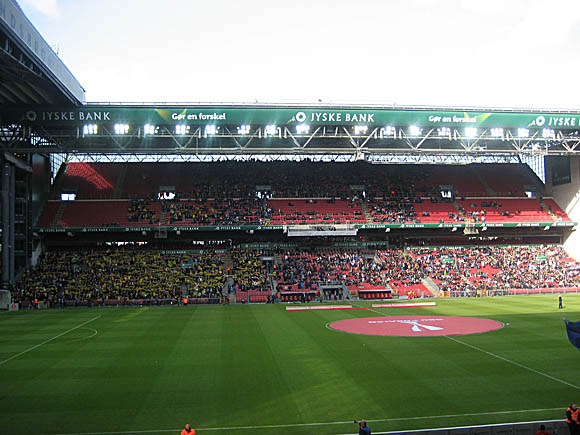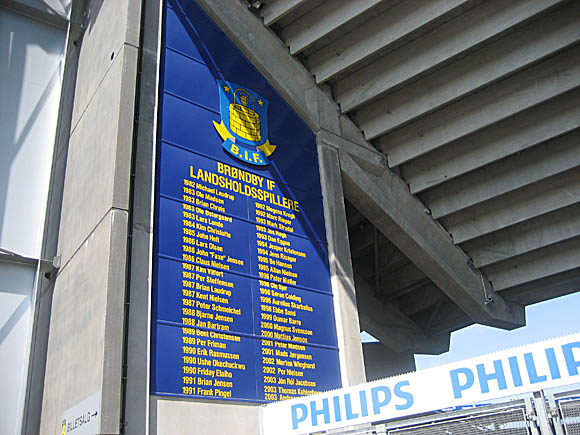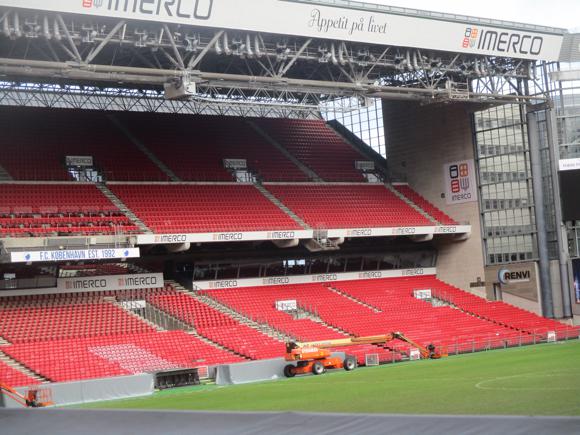A fan’s guide – the club from early doors to today
Over the last decade or more, FC Copenhagen have gone from shambolic underachievers to regular champions, winning 13 titles this century – most recently in 2022. FCK were also the first Danish club to make the last 16 of the Champions League.
Conveniently coinciding with the building of the stadium they share with the national side, the Parken, FC Copenhagen were established in 1992 as a merger between traditional clubs KB and B1903.

B1903 had a great team – they had beaten Bayern Munich 6-2 in the UEFA Cup and made the quarter-finals – but the club was only kept afloat by an ageing patron, ex-player Alex Friedmann. KB were playing in the second tier to tiny crowds at a shabby athletics stadium. The new national stadium needed a league club as tenant, and so FCK were born out of necessity – but their potential was huge.
That potential was wasted for most of the 1990s. Brøndby bounced back to dominate the domestic scene while FCK were days from entering administration in 1995. In 2000, things picked up. FCK had bought the Parken and used part of its considerable revenue to attract coach Roy Hodgson.
FCK finally won a title in 2001, and then made a habit of it throughout the decade. Financial woes returned, but with former player Ståle Solbakken as coach, and Jesper Grønkjaer and Senegalese revelation Dame N’Doye at his disposal, the debt nightmare didn’t seemed to harm the team.

Harm came with replacing the departing Solbakken, who went off to try his luck in Cologne and Wolverhampton. The lowest ebb came when sports director Carsten V Jensen, now at Brøndby, acted as stand-in manager. FCK limply surrendered a solid lead and the 2012 title to FC Nordsjaelland.
Normal service was restored – eventually – by a returning Ståle Solbakken. By 2016, FCK were back in style, local players such as Thomas Delaney, Andreas Cornelius and Matthias Zanka dominating the league and grabbing the double after an explosive final against Brøndby.
Solbakken’s side was basically too good for the Superliga, and when the top players were sold off, the next ones failed to gel. Fourth place in 2018 was a huge disappointment, and European qualification was only secured at the death in a play-off.

Under new captain, Greek international Zeca, 2018-19 held more promise, with a win on penalties over a resurgent Atalanta in Europe and, albeit narrowly over Midtjylland, a 13th league title at home. The subsequent European adventure proved eventful, starting with a ridiculous exit against ten-man Red Star Belgrade, the penalty shoot-out taken from a wobbly spot on a pitch ruined by heavy summer rain. Copenhagen missed five.
Then came a tense Europa League campaign with a fraught Øresund derby against Malmö, who finished top of the group. A late own goal by FCK’s Swedish international Sotirios Papagiannopoulos at Parken proved decisive.
With enough in the tank to qualify for another knock-out stage in 2020, FCK settled into their familiar role as lone flag-carriers for Denmark in Europe while sensing their league title slip away to a ever-stronger Midtjylland.

An impressive win at Celtic Park in February 2020, goals from returning Senegalese international Dame N’Doye adding to his club record total, led to a one-off Europa League quarter-final with Manchester United at the height of the pandemic. At an empty neutral stadium in Cologne, FCK kept the scoresheet blank thanks to heroics from Swedish international keeper Karl-Johan Johnsson but eventually fell to a penalty in extra-time.
With the veteran N’Doye out of the frame, focus fell on young Danish international Jonas Wind and Mallorcan attacking midfielder Pep Biel, whose goals pushed FCK to the top of their Conference League group in 2021. A ding-dong 4-4 draw at PSV Eindhoven nicely set up a second leg at a packed Parken but Dutch experience proved decisive.
By now, Solbakken’s replacement, ex-Midtjylland manager Jess Thorup was just getting into his stride and his tight defensive unit kept the goals against tally low to claim the Danish title in 2022. Reaching the group stage of the Champions League for the first time since 2016, FCK looked well out of their depth, a poor league campaign compounding Thorup’s woes. His assistant, Jacob Neestrup, now needs more goals from Biel and Swedish international Viktor Claesson if FCK are to salvage something from the 2022-23 campaign.








Stadium Guide
The field of dreams – and the stands around it




Parken doubles up as FC Copenhagen’s home ground and Denmark’s national stadium for qualifiers. For FCK games, older, more relaxed home fans occupy the Nedre (Lower) C Tribune, the younger, all-singing the Nedre (and sometimes the Øvre, Upper) B. Note that there are no under-15s allowed in B Tribune, section 12, and no allocated seats.
Nedre A is for sponsors, Øvre A and C are for neutrals, and D is for families. Away fans are usually placed in the left top tier of the A Tribune – if in more serious numbers, they are allocated the D Tribune.
For details of transport and nearby bars, see Parken.
tickets, shop & museum
Buying tickets and merchandise



The FCK Fanshop (Mon-Fri 10am-6pm, Sat 10am-4pm, Sun 11am-4pm, match days) is on the park side of the stadium, at the corner of Stands C and D. Expansive megastore, ticket outlet and museum in one – head to the back of the shop for the free FCK Experience – this is more than just an outlet for replica shirts (the usual white with blue trim, away Inter-like blue-and-black stripes and unwise bright pink third choice for 2022-23). Other accessories include branded beach towels, sunglasses and an FCK confetti shooter, perhaps handy for weddings.
The ticket outlet is the long counter to the left as you enter the shop. Online sales are Danish-only. Tickets are usually sold for three or four home games in advance. With a capacity of 38,000 and the average attendances under half that, only top European fixtures sell out.
Domestic fixtures are priced in three categories. For top Category A games, the cheapest seats in the C Tribune along the sideline are in the corner sectors C1 and C15, Dkr125 (Dkr65 for 5-14s). Most other seats closer to the halfway line are Dkr235-260 (Dkr145-160 for 5-14s). Behind the home goal in section 12 of the B Tribune, it’s Dkr100 in the Upper (Øvre), Dkr185 in the Lower (Nedre) sections, over-15s only.






Away fans are charged Dkr185 for a seat in the D Tribune. For B and C games, prices range from Dkr100-185 in the C Tribune, Dkr200-220 in sectors C6-10 over the halfway line – 5-14s are charged half-price pretty much across the board. It’s Dkr135 in the home (no under-15s) and away ends, Dkr70 for 5-14s with visiting supporters. An extra Dkr40 is added to buying on the day, also from the club shop.
Comprising two rooms of souvenirs, the FCK Experience displays the club’s shirts through the ages, match tickets, programmes and pennants for past top European games and a wall of fame. All is centrepieced by the Danish league trophy, won in 2019. To one side, a door leads to a viewing platform within the stadium – if it’s locked, ask the staff to let you in.







